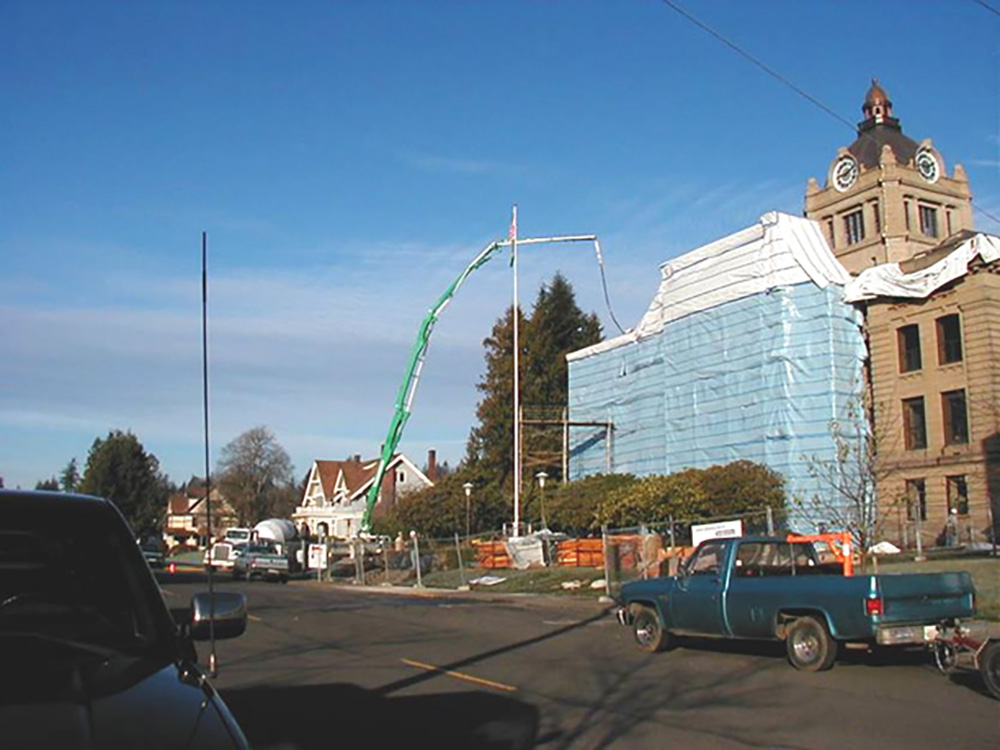In the spring of 2010, my daughter and I were privileged to accompany some coworkers on a trip to France. One of my coworkers grew up in France, and his retired father owns a manor house in the Normandy region built in 1849 on property that has early affiliations with King Charles IX. One of the profound takeaways from this trip was the European appreciation for things of the past. From the detailed brick arch foundation support columns in the basement to the ornate decorations on the three floors above, it was evident that the current and previous owners all appreciate the “story” behind the structure and want to preserve it to the extent possible while still making it habitable for the modern lifestyle.
Preserving History While Improving Safety & Function
Thankfully, Reid Middleton occasionally has the opportunity to leave our own mark on historic structures. One of my memories from 25 years with Reid Middleton is the work our Structural Group did for the Grays Harbor Courthouse. I have always loved old courthouses. The grand spaces, the marble steps, the liberal use of dark hardwoods, the old wood doors with transoms above them; all combine to give that air of permanence and authority.
Reid Middleton was the structural engineer and led a multi-disciplinary design team for the seismic rehabilitation and renovation of the five-story, 35,000 square foot ornate historic courthouse constructed in 1906. The project received a Project of the Year Award from the American Public Works Association for its attention to detail and design excellence. When our design team got done, and the contractors did their handiwork, you could not tell anything had changed, despite it having been through the 1999 Satsop earthquake. That’s just the way you want a 109-year old building to look!
Fast forward about 10 years to another project involving a historic structure. I managed a team to re-purpose an old hospital building. Building 491 at Naval Base Kitsap-Bremerton (NBK) was built during World War II and when built was dubbed the “Sick Officer’s Quarters.” The original building is one of two surviving buildings of the Naval Hospital Reservation Historic District and the entire restoration was subject to review by the State Historic Preservation Office (SHPO).
The hospital is a three-story structure with a basement that “daylights” to the west. The architecture is that classical red brick federal style that reminds me a lot of all the neat old brick buildings I encountered at Ft. Belvoir in Virginia during my Officer’s Basic Training. The SHPO had a keen interest in seeing the exterior appearance modified as little as possible, while realizing that significant changes would be made in the interior to make it safe and suitable to house the Navy College, the Navy-Marine Corps Relief Society, and the offices of the Base Chaplain. You can read more about this project in a post by structural engineer, Drew Martin.
When Work is More Than a Job
My Dad “flew a desk” (as he used to say) at Aberdeen Proving Ground in Baltimore during World War II. One of my uncles kept the planes flying during the assault on Sicily and Italy as a mechanic with the Army Air Force and another uncle piloted and got shot down in a P-38 Lightning over Czechoslovakia. The mechanic uncle was briefly stationed at Paine Field during his military stint, just up the road from Reid Middleton’s Everett, Washington, office. As a result of my family’s history, I have a personal affinity for stories of the old World War II fighter planes and bombers.
My nostalgia made it fun to manage my most recent project related to a historic structure: the study of the potential market for salvage of historic elements of Hangar 1 at Naval Air Station Whidbey Island (NASWI). Hangar 1 was built in 1943 by The Austin Company to support the World War II effort.
I had managed a similar study of the hangar back in 2006 with the intent of ascertaining the cost of demolition as well as the cost to relocate the structure somewhere on the base. In the intervening years, NASWI has been targeted for substantial growth, and the pressures to do something with the hangar resulted in the Navy awarding demolition of the hangar as a contract option. However, in cooperation with SHPO, they also commissioned the market study to gauge public interest in the salvage aspect. As part of the study, the Reid Middleton team identified two parties that expressed interest in acquiring the hangar and reconstructing it on separate Puget Sound region airports to house historic aircraft collections. I facilitated a meeting between one party and a Navy representative, which may result in a new forever home for the salvageable portions of the hangar.
So, be on the lookout for a new hangar project one of these days that looks remarkably like what would have been built in World War II and go enjoy history up close and personal!

